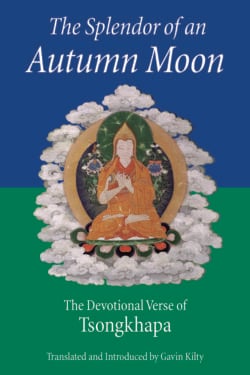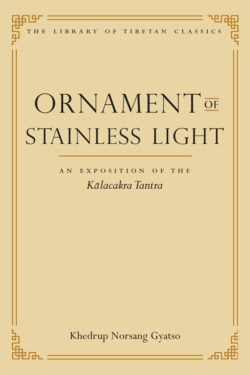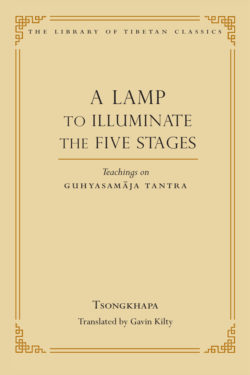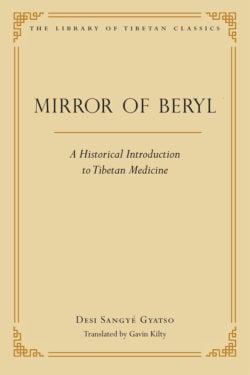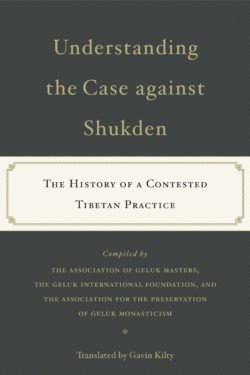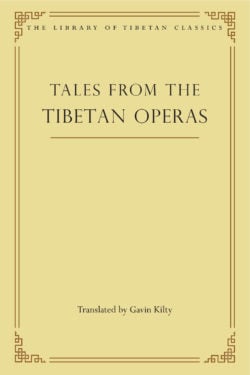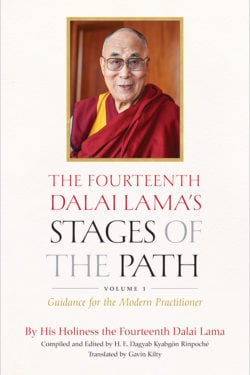Gavin Kilty

Gavin Kilty has been a full-time translator for the Institute of Tibetan Classics since 2001. Before that he lived in Dharamsala, India, for fourteen years, where he spent eight years training in the traditional Geluk monastic curriculum through the medium of class and debate at the Institute of Buddhist Dialectics. He also teaches Tibetan language courses in India, Nepal, and elsewhere, and is a translation reviewer for the organization 84000, Translating the Words of the Buddha.
Books, Courses & Podcasts
The Splendor of an Autumn Moon
The print version of this book is currently out of stock. Check back soon.
The Tibetan saint Tsongkhapa (1357-1419), the founder of the Dalai Lama’s tradition of Tibetan Buddhism, was renowned for his vast learning, meditational achievements, influential writings on practice and philosophy, and reform of tantric religious practices. A deeply humble and religious man, he expressed himself in exquisite verse.
Here, presented in both the original Tibetan and in English translation, are twenty-one devotional poems by Tsongkhapa. Each verse—dedicated to the Buddha, bodhisattvas, and lamas—illuminates some aspect of the Buddhist path. Gavin Kilty’s commentary places each prayer into context, and his careful, artful translations will appeal to anyone with a love of poetry.
Ornament of Stainless Light
The premiere volume of Thupten Jinpa’s thirty-two-volume Library of Tibetan Classics series, inaugurated to coincide with the Dalai Lama’s conferral of the initiation rite of Kālacakra in Toronto in April 2004.
The Kālacakra, or “wheel of time,” tantra likely entered Indian Mahayana Buddhism around the tenth century. In expounding the root tantra, the Indian master Puṇḍarīka, one of the legendary Kalkī kings of the land of Shambhala, wrote his influential Stainless Light. Ornament of Stainless Light is an authoritative Tibetan exposition of this important text, composed in the fifteenth century by Khedrup Norsang Gyatso, tutor to the Second Dalai Lama.
One of the central projects of Kālacakra literature is a detailed correlation between the human body and the external universe. In working out this complex correspondence, the Kālacakra texts present an amazingly detailed theory of cosmology and astronomy, especially about the movements of the various celestial bodies. The Kālacakra tantra is also a highly complex system of Buddhist theory and practice that employs vital bodily energies, deep meditative mental states, and a penetrative focus on subtle points within the body’s key energy conduits known as channels. Ornament of Stainless Light addresses all these topics, elaborating on the external universe, the inner world of the individual, the Kālacakra initiation rites, and the tantric stages of generation and completion, all in a highly readable English translation.
Learn more about the Library of Tibetan Classics
Learn about becoming a benefactor of the Library of Tibetan Classics
A Lamp to Illuminate the Five Stages
First Place Winner of 2017 Shantarakshita Award for Excellence in Translation from the Tsadra Foundation
Tsongkhapa’s A Lamp to Illuminate the Five Stages (1419) is a comprehensive presentation of the highest yoga class of Buddhist tantra, especially the key practices—the so-called five stages (pancakrama)—of the advanced phase of Guhyasamāja tantra. Beginning with a thorough examination of the Indian sources, Tsongkhapa draws particularly from the writings of Nāgārjuna, Aryadeva, Candrakīrti, and Nāropā to develop a definitive understanding of the Vajrayana completion stage. Whereas in the generation stage, meditators visualize the Buddha in the form of the deity residing in a mandala palace, in the completion stage discussed in the present volume, meditators transcend ordinary consciousness and actualize the state of a buddha themselves. Among other things, Tsongkhapa’s work covers the subtle human physiology of channels and winds along with the process of dying, the bardo, and rebirth. This definitive statement on Guhyasamaja tantra profoundly affected the course of Buddhist practice in Tibet.
Learn more about the Library of Tibetan Classics
Learn about becoming a benefactor of the Library of Tibetan Classics
Mirror of Beryl
Composed while its author was the ruler of Tibet, Mirror of Beryl is a detailed account of the origins and history of medicine in Tibet through the end of the seventeenth century. Its author, Desi Sangyé Gyatso (1653–1705), was the heart disciple and political successor of the Great Fifth Dalai Lama and the author of several highly regarded works on Tibetan medicine, including his Blue Beryl, a commentary on the foundational text of Tibetan medicine, The Four Tantras. In the present historical introduction, Sangyé Gyatso traces the sources of influence on Tibetan medicine to classical India, China, Central Asia, and beyond, providing life stories, extensive references to earlier Tibetan works on medicine, and fascinating details about the Tibetan approach to healing. He also provides a commentary on the pratimoksha, bodhisattva, and tantric Buddhist vows. Desi Sangyé Gyatso’s Mirror of Beryl remains today an essential resource for students of medical science in Tibet.
Learn more about the Library of Tibetan Classics
Learn about becoming a benefactor of the Library of Tibetan Classics
Understanding the Case Against Shukden
Before the twentieth century, the figure of Shukden, or Dölgyal, was an obscure one in the pantheon of Tibetan Buddhism’s many oracles and protectors. But after individuals within the Geluk tradition began to promote and disseminate the practice, division arose among Buddhists of different sects. Later, incidents within the exile community, as recounted in this book, prompted the Dalai Lama to investigate the practice more deeply. The fruits of this research are presented here, as are the statements made by His Holiness about it over the past forty years. Understanding the Case against Shukden uncovers the historical context behind this contentious practice, which dates back to the time of the Fifth Dalai Lama in the seventeenth century, and clarifies why the present Dalai Lama has been so vocal in countering it.
Understanding the Case against Shukden is a clarion call for unity among the Tibetan people and a vision for a more harmonious Tibetan Buddhist community.
Tales from the Tibetan Operas
In Tales from the Tibetan Operas, timeless Buddhist ideas are brought to life through enchanting myths and vivid stories. Poetically vibrant, these eight classic lhamo stories have continued to delight and edify Tibetan audiences of all backgrounds, from village children to learned scholar-monks and Dalai Lamas.
Western readers can now get a glimpse into ancient Indian and Tibetan mythology through the cultural touchstone of eight classic lhamo stories. On visual display are the human and nonhuman characters of history and folklore — kings, queens, conniving ministers, ordinary folk, yogis, monks, and powerful beings from other realms such as gods and nāgas — engaged in plotting, kidnapping, fighting, journeys to faraway lands, separation, and reconciliation, often with a quest for seemingly impossible treasure. The suspenseful tales have many dramatic plot twists, but they all end in happiness, where the good achieve their goals and the bad receive their just desserts. The operas thus bring to the people the fundamental ethical laws of behavior and teachings of natural justice based on Buddhist doctrine.
The book features more than 50 gorgeous photos of the operas performed on location in Tibet and India.
Learn more about the Library of Tibetan Classics
Learn about becoming a benefactor of the Library of Tibetan Classics
The Fourteenth Dalai Lama’s Stages of the Path, Volume 1
Discover His Holiness the Dalai Lama’s advice for finding happiness, helping others, and applying insights from Buddhist thought to everyday life—for a life of greater harmony, meaning, and joy, for ourselves, others, and in our world.
This first volume of The Fourteenth Dalai Lama’s Stages of the Path shares His Holiness’s teachings on specific topics of vital relevance to contemporary life:
– how kindness and compassion are the foundation for individual happiness and world peace;
– how we can solve manmade problems;
– how Buddhism does not conflict with modern science and can actually contribute to its advancement;
– how gender equality is fundamental for a decent and just society;
– and much more.
His Holiness’s messages on these topics will be of value to all readers, Buddhists and non-Buddhists alike. These teachings embody the Dalai Lama’s generous warmth and humor, his expertise in presenting important Buddhist ideas, and his ability to inspire us toward greater kindness and happiness.
The Fourteenth Dalai Lama’s Stages of the Path, Volume 2: An Annotated Commentary on the Fifth Dalai Lama’s Words of Mañjuśrī is also available.
Light of Samantabhadra
A gateway to Indian philosophy and its explication in Tibet.
Among the many works produced in the rich philosophical tradition of India’s classical age, few have had more impact than Dharmakīrti’s Commentary on Valid Cognition (Pramāṇavārttika). Composed in India in the seventh century, it became the cornerstone for the study of logic and epistemology in the Tibetan Buddhist tradition.
This work translated here is by one of the premier scholars of the Sakya school, Gorampa Sönam Sengé (1429–89). It illuminates the first two chapters of Dharmakīrti’s work, those on using inference to enlighten oneself (svārthānumāna) and on establishing valid cognition (pramāṇasiddhi) both to determine the authority of the Buddha as a valid teacher and to eliminate the cognitive obstacles to awakening. The root text is composed in compact verses, and these are translated here along with Gorampa’s word-by-word commentary that reveals their often veiled meanings. These chapters explore key issues in the philosophy of language and the nature of conventional designation, the way to employ sound reasoning, the proof of past and future lives, and the way to eliminate the view of self. In the skilled hands of translator Gavin Kilty, these insights are made accessible.
Light of Samantabhadra is the first volume in a new academic series from Wisdom and the Khenpo Appey Foundation. The Khenpo Appey Collection of Sakya Classics aspires to fulfill Khenchen Appey Rinpoche’s vision of making important and authoritative Sakya works accessible to English-speaking audiences. This series, conceived by the Khenpo Appey Foundation and published by Wisdom Publications, will contain translations of texts central to Tibetan Buddhist study composed by influential Sakya masters to provide a holistic and comprehensive presentation of Buddhist thought and philosophy.

